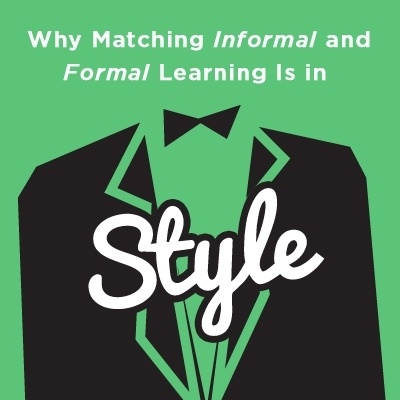“Think about how you typically learn and work,” says Patty Shank, eLearning Guild Director of Research, “And you begin to realize how much you depend on co-workers, conversations, networking, the Internet, collaboration, and so on.” Formal learning depends on the social and spontaneous nature of informal learning.Matching informal and formal learning is an effective learning strategy. Here’s why:
- Informal learning helps us remember what we learned in a formal setting.If you’re looking for a way to improve your formal training by increasing employee retention of information, try informal learning. It allows employees to continue learning and increases associations with relevant information. All the knowledge they’ve just learned becomes meaningful as it’s reinforced in an informal setting, and this also helps them remember. For more ways to help your employees remember content, check out this post: 6 Memory Tricks to Use on Your e-Learners.
- Teaching inspires discussion and collaboration.If you provide an informal setting for discussion, your employees gain the opportunity to learn collaboratively. According to learning scholar Clark Quinn, “Having people work together to craft a statement, document an approach, or generate a response can be a powerful tool for developing a shared understanding.” They can ask other learners questions and find out what their coworkers’ understanding of the topics is, which can influence their own interpretation of what they’ve just learned.
Check out these classy style tips for matching informal and formal learning in your online training programs
- Don’t be a control freak with informal learning.Informal learning works because it’s a natural type of learning, so trying to force or control it could kill it completely. However, there’s a good place for more control—formal learning. Put your effort into making sure your formal programs are structured and organized, so you can let informal learning supplement and complement it. One way to plan your formal programs before you start designing them is by storyboarding. Check out this blog post for tips on storyboarding: Storyboarding Online Training Courses With Your Team.
- Do support informal learning, so it can grow.Informal learning needs a place to thrive, which you can provide with a learning management system that allows quick and easy knowledge sharing, like the new Lectora Express – The Easy LMS. This enables employees to pass documents around to each other so that they keep learning even when formal training isn’t in session. For help, take a look at this Checklist for Choosing an Online LMS.
- Really polish your formal learning.Formal learning has a bad reputation for being boring and forced, but it doesn’t have to be! Make it a priority to create engaging and interactive formal learning courses at your organization. If the foundation of formal learning is engaging and innovative, the informal learning that stems from it will be even more productive. For helpful tips on how to create fun and engaging training, check out this blog post: How to Make Online Compliance Training More FUN.
Informal and formal learning are both in style, so use these tips to match them successfully in your e-Learning training programs. When used strategically, these two types of learning that depend on each other will benefit your whole organization.Want to learn more about informal learning? Check out this blog post: Top 3 Informal Learning Tips

